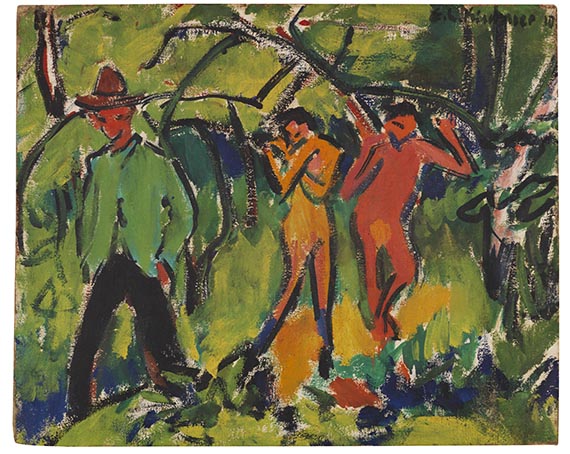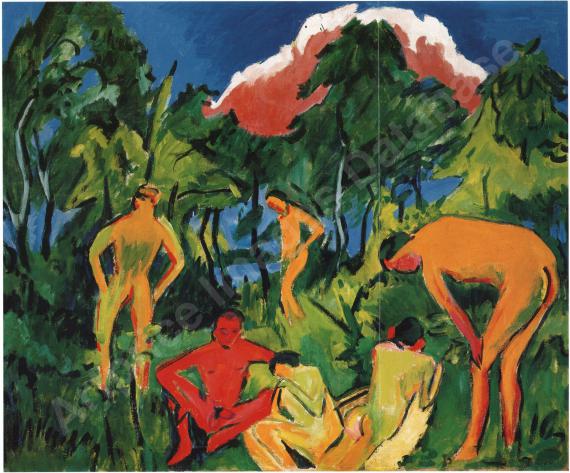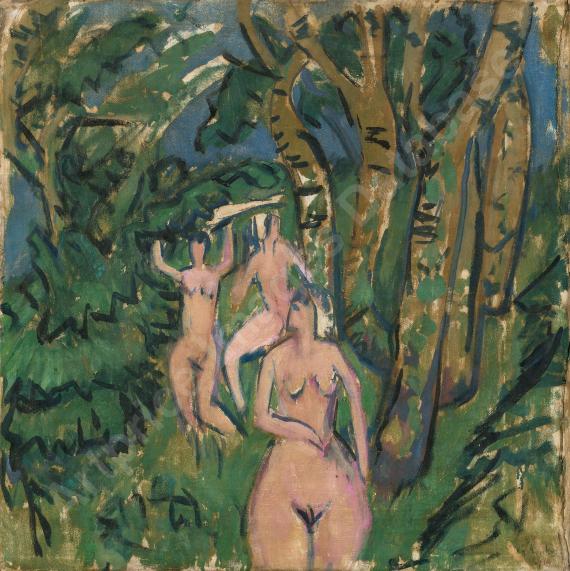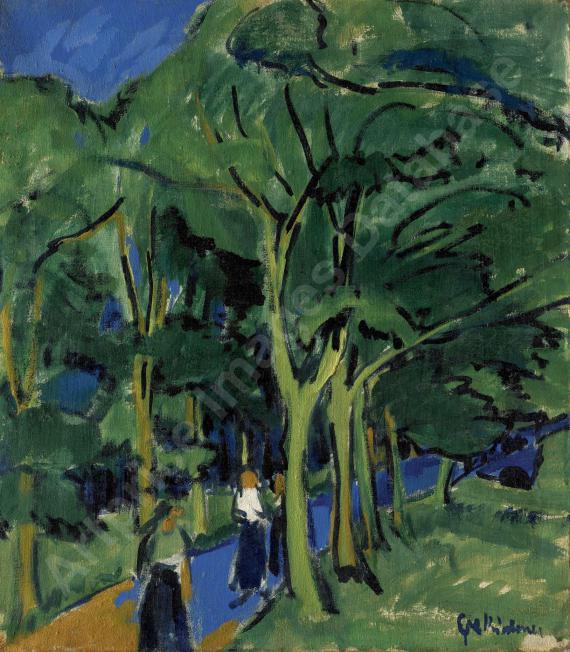Vente: 550 / Evening Sale 07 juin 2024 à Munich  Lot 122000467
Lot 122000467
 Lot 122000467
Lot 122000467
122000467
Ernst Ludwig Kirchner
Im Wald, 1910.
Oil on canvas
Estimation: € 400,000 / $ 428,000
Les informations sur la commission d´achat, les taxes et le droit de suite sont disponibles quatre semaines avant la vente.
Im Wald. 1910.
Oil on canvas.
Gordon 142. Signed and dated in upper right. 58 x 70 cm (22.8 x 27.5 in).
The painting " Zwei Menschen im Freien" by Erich Heckel, made around the same time as Ernst Ludwig Kirchner's "Im Wald", is also offered in this auction. [SM].
• A masterpiece of "Brücke" art from the Dresden period.
• The highlight of the group's collective activities, created during the group's visits to the Moritzburg Ponds.
• The immediacy of the unconstrained depiction of nudes in untouched nature is a guiding principle of "Brücke" art.
• Shortly after its completion, the painting featured in the legendary exhibition at Galerie Arnold in Dresden in September 1910 (according to Donald E. Gordon).
This work is documented in the Ernst Ludwig Kirchner Archive, Wichtrach/Bern.
PROVENANCE: Galerie Neupert, Zürich (with the label on the reverse).
Collection Werner Brunner, Sankt Gallen (acquired from the above in 1953).
Collection Hermann Gerlinger, Würzburg (with the collector's stamp Lugt 6032).
EXHIBITION: Dresden 1910, no. 26 (there with the title "Landschaft").
E. L. Kirchner und Rot-Blau, Kunsthalle Basel, September 2 – October 15, 1967, cat. no. 16.
E. L. Kirchner. Gemälde, Aquarelle, Zeichnungen und Druckgraphik, Kunstverein in Hamburg, December 6, 1969 – January 25, 1970, Frankfurter Kunstverein, Frankfurt am Main, February 6 – March 29, 1970, cat. no. 19 (with illu., no. 34).
Künstler der Brücke an den Moritzburger Seen 1909-1911, Brücke-Museum, Berlin, cat. no. 33 (with illu., p. 17).
Paul Gauguin. Das verlorene Paradies, Museum Folkwang, Essen, June 17, 1998 – October 18, 1998, Neue Nationalgalerie, Berlin, October 31, 1998 – January 10, 1999, cat. no. E 5 (with illu.).
Frauen in Kunst und Leben der "Brücke", Schleswig-Holsteinisches Landesmuseum, Schloss Gottorf, Schleswig, September 10 – November 5, 2000, cat. no. 52 (with illu. p. 138).
Die Brücke in Dresden 1905-1911, Dresdner Schloss, Staatliche Kunstsammlungen Dresden, Galerie Neue Meister, October 20, 2001 – January 6, 2002, cat. no. 266 (with illu., p. 221).
Die "Brücke" und die Moderne 1904-1914, Bucerius Kunst Forum, Hamburg, October 17, 2004 – January 23, 2005, cat. no. 133 (with illu. p. 158).
Im Rhythmus der Natur: Landschaftsmalerei der Brücke, Städtische Galerie, Ravensburg, October 28, 2006 – January 28, 2007, p. 83 (with illu. p. 82).
Expressiv! Die Künstler der Brücke. Die Sammlung Hermann Gerlinger, Albertina Vienna, June 1 – August 26, 2007, cat. no. 144 (with illu., p. 229).
Der Blick auf Fränzi und Marcella. Zwei Modelle der Brücke-Künstler Heckel, Kirchner und Pechstein, Sprengel-Museum, Hanover, August 29, 2010 – January 9, 2011, Stiftung Moritzburg, Kunstmuseum des Landes Sachsen-Anhalt, Halle (Saale), February 6 – 15, 2011, cat. no. 81 (with illu., p. 111).
'Keiner hat diese Farben wie ich.' Kirchner malt, Kirchner-Museum, Davos, December 4, 2011 - April 15, 2012, p. 29 (with illu.).
Brückenschlag: Gerlinger – Buchheim!, Buchheim Museum, Bernried, October 28, 2017 - February 25, 2018, pp. 184-187 (with illu.).
LITERATURE: Donald E. Gordon, Ernst Ludwig Kirchner. Mit einem kritischen Katalog sämtlicher Gemälde, München/Cambridge (Mass.) 1968, pp. 69 and 294, cat. no. 142 (with illu.).
- -
Estate of Donald E. Gordon, University of Pittsburgh, Gordon Papers, series I., subseries 1, box 1, folder 143.
Leopold Reidemeister, Künstler der "Brücke" an den Moritzburger Seen 1909-1911. Erich Heckel, Ernst Ludwig Kirchner, Max Pechstein, in: Ex. cat. Künstler der "Brücke" an den Moritzburger Seen 1909-1911, Brücke-Museum, Berlin, 1970, p. 18.
Mario-Andreas von Lüttichau, Künstlergemeinschaft "Brücke", in: Ex. cat. Stationen der Moderne. Die bedeutendsten Kunstausstellungen des 20. Jahrhunderts in Deutschland, Berlinische Galerie, Berlin, 1988/89, p. 90 (with illu., no. 1/8).
Heinz Spielmann (ed.), Die Maler der Brücke, Sammlung Hermann Gerlinger, Stuttgart 1995, p. 153, SHG no. 147 (with illu.).
Heinz Spielmann, Die Brücke und die Moderne 1904-1914, in: Vernissage Nord, Ausstellungen Herbst/Winter, 2004/05, p. 8 (with illu.).
Hermann Gerlinger, Katja Schneider (ed.), Die Maler der Brücke, inventory catalog Collection Hermann Gerlinger, Halle (Saale) 2005, p. 316, SHG no. 712 (with illu.)
Franz Schwarzbauer, Andreas Gabelmann (eds.), Im Rhythmus der Natur: Landschaftsmalerei der "Brücke". Meisterwerke der Sammlung Hermann Gerlinger, Ostfildern 2006, pp. 23ff
Volkmar Billig, 'Gefilde der Seligen'. Zur Inselfaszination der "Brücke"-Künstler, in: Christoph Wagner and Ralph Melcher (eds.), Die "Brücke" und der Exotismus. Bilder des Anderen, Berlin 2011, p. 21 (with illu., no. 4, p. 23).
"We had been familiar with the landscape for quite some time, and we knew that we could paint plein-air nudes without any disturbances [..]. We were living in a state of absolute harmony, we worked and bathed. Whenever we were short of a male model as counterpart, one of us would fill in."
Hermann Max Pechstein, Erinnerungen, 1993, p. 41.
Oil on canvas.
Gordon 142. Signed and dated in upper right. 58 x 70 cm (22.8 x 27.5 in).
The painting " Zwei Menschen im Freien" by Erich Heckel, made around the same time as Ernst Ludwig Kirchner's "Im Wald", is also offered in this auction. [SM].
• A masterpiece of "Brücke" art from the Dresden period.
• The highlight of the group's collective activities, created during the group's visits to the Moritzburg Ponds.
• The immediacy of the unconstrained depiction of nudes in untouched nature is a guiding principle of "Brücke" art.
• Shortly after its completion, the painting featured in the legendary exhibition at Galerie Arnold in Dresden in September 1910 (according to Donald E. Gordon).
This work is documented in the Ernst Ludwig Kirchner Archive, Wichtrach/Bern.
PROVENANCE: Galerie Neupert, Zürich (with the label on the reverse).
Collection Werner Brunner, Sankt Gallen (acquired from the above in 1953).
Collection Hermann Gerlinger, Würzburg (with the collector's stamp Lugt 6032).
EXHIBITION: Dresden 1910, no. 26 (there with the title "Landschaft").
E. L. Kirchner und Rot-Blau, Kunsthalle Basel, September 2 – October 15, 1967, cat. no. 16.
E. L. Kirchner. Gemälde, Aquarelle, Zeichnungen und Druckgraphik, Kunstverein in Hamburg, December 6, 1969 – January 25, 1970, Frankfurter Kunstverein, Frankfurt am Main, February 6 – March 29, 1970, cat. no. 19 (with illu., no. 34).
Künstler der Brücke an den Moritzburger Seen 1909-1911, Brücke-Museum, Berlin, cat. no. 33 (with illu., p. 17).
Paul Gauguin. Das verlorene Paradies, Museum Folkwang, Essen, June 17, 1998 – October 18, 1998, Neue Nationalgalerie, Berlin, October 31, 1998 – January 10, 1999, cat. no. E 5 (with illu.).
Frauen in Kunst und Leben der "Brücke", Schleswig-Holsteinisches Landesmuseum, Schloss Gottorf, Schleswig, September 10 – November 5, 2000, cat. no. 52 (with illu. p. 138).
Die Brücke in Dresden 1905-1911, Dresdner Schloss, Staatliche Kunstsammlungen Dresden, Galerie Neue Meister, October 20, 2001 – January 6, 2002, cat. no. 266 (with illu., p. 221).
Die "Brücke" und die Moderne 1904-1914, Bucerius Kunst Forum, Hamburg, October 17, 2004 – January 23, 2005, cat. no. 133 (with illu. p. 158).
Im Rhythmus der Natur: Landschaftsmalerei der Brücke, Städtische Galerie, Ravensburg, October 28, 2006 – January 28, 2007, p. 83 (with illu. p. 82).
Expressiv! Die Künstler der Brücke. Die Sammlung Hermann Gerlinger, Albertina Vienna, June 1 – August 26, 2007, cat. no. 144 (with illu., p. 229).
Der Blick auf Fränzi und Marcella. Zwei Modelle der Brücke-Künstler Heckel, Kirchner und Pechstein, Sprengel-Museum, Hanover, August 29, 2010 – January 9, 2011, Stiftung Moritzburg, Kunstmuseum des Landes Sachsen-Anhalt, Halle (Saale), February 6 – 15, 2011, cat. no. 81 (with illu., p. 111).
'Keiner hat diese Farben wie ich.' Kirchner malt, Kirchner-Museum, Davos, December 4, 2011 - April 15, 2012, p. 29 (with illu.).
Brückenschlag: Gerlinger – Buchheim!, Buchheim Museum, Bernried, October 28, 2017 - February 25, 2018, pp. 184-187 (with illu.).
LITERATURE: Donald E. Gordon, Ernst Ludwig Kirchner. Mit einem kritischen Katalog sämtlicher Gemälde, München/Cambridge (Mass.) 1968, pp. 69 and 294, cat. no. 142 (with illu.).
- -
Estate of Donald E. Gordon, University of Pittsburgh, Gordon Papers, series I., subseries 1, box 1, folder 143.
Leopold Reidemeister, Künstler der "Brücke" an den Moritzburger Seen 1909-1911. Erich Heckel, Ernst Ludwig Kirchner, Max Pechstein, in: Ex. cat. Künstler der "Brücke" an den Moritzburger Seen 1909-1911, Brücke-Museum, Berlin, 1970, p. 18.
Mario-Andreas von Lüttichau, Künstlergemeinschaft "Brücke", in: Ex. cat. Stationen der Moderne. Die bedeutendsten Kunstausstellungen des 20. Jahrhunderts in Deutschland, Berlinische Galerie, Berlin, 1988/89, p. 90 (with illu., no. 1/8).
Heinz Spielmann (ed.), Die Maler der Brücke, Sammlung Hermann Gerlinger, Stuttgart 1995, p. 153, SHG no. 147 (with illu.).
Heinz Spielmann, Die Brücke und die Moderne 1904-1914, in: Vernissage Nord, Ausstellungen Herbst/Winter, 2004/05, p. 8 (with illu.).
Hermann Gerlinger, Katja Schneider (ed.), Die Maler der Brücke, inventory catalog Collection Hermann Gerlinger, Halle (Saale) 2005, p. 316, SHG no. 712 (with illu.)
Franz Schwarzbauer, Andreas Gabelmann (eds.), Im Rhythmus der Natur: Landschaftsmalerei der "Brücke". Meisterwerke der Sammlung Hermann Gerlinger, Ostfildern 2006, pp. 23ff
Volkmar Billig, 'Gefilde der Seligen'. Zur Inselfaszination der "Brücke"-Künstler, in: Christoph Wagner and Ralph Melcher (eds.), Die "Brücke" und der Exotismus. Bilder des Anderen, Berlin 2011, p. 21 (with illu., no. 4, p. 23).
"We had been familiar with the landscape for quite some time, and we knew that we could paint plein-air nudes without any disturbances [..]. We were living in a state of absolute harmony, we worked and bathed. Whenever we were short of a male model as counterpart, one of us would fill in."
Hermann Max Pechstein, Erinnerungen, 1993, p. 41.
The speed and intensity of urbanisation in Germany during the early twentieth century provoked an anti-urban counter movement advocating sun and air therapy, among other reformist ideas aimed at ‘healing’ modern society. For example, in the same year that the "Brücke" artists founded their group (1905), the Society for Forest Relaxation was inaugurated to promote ‘fresh air culture’ in the woods surrounding Dresden; several nudist bathing resorts were also established in the countryside around the city (see Jill Lloyd, German Expressionism, Primitivism and Modernity, 1991 p.110 f.).
Kirchner and the other Brücke artists embraced the ethos of these reformist ideas, fusing them with their own desire to renew the art and culture of their times. Together with Brücke artists Erich Heckel and Max Pechstein, and a group of friends and models, Kirchner spent the summer of 1910 in Moritzburg, painting and skinny-dipping in the forest ponds. The artists emulated what they understood as a ‘primordial’ lifestyle, inspired by tribal artifacts they discovered in the Dresden Ethnographic Museum and exhibitions of tribal villages Kirchner visited and sketched in the Dresden Zoo, which was intended to stimulate popular interest in German colonialism. In the forest and lakes surrounding Motitzburg, the artists often set up their easels side by side, recording the same scenes: hence the nude couple in Kirchner’s "Im Wald", reappears in Heckel’s "Zwei Menschen im Freien" (1909/10), where the left-hand nude crosses her arms protectively across her chest in a similar gesture, and the same yellow and red flesh tones recur. Indeed, the casually dressed man in the foreground of Kirchner’s painting is probably Erich Heckel, walking towards his easel to pick up his paints and brushes.
The Pictorial Coalescence of Kirchner's Figures With Surrounding Nature
The sketchy, androgynous nudes in Kirchner’s painting partially merge with surrounding nature: their contours rhyme with the boughs of the trees, the figure with crossed arms blends coloristically with the sunlit forest glade, and sketchy, spontaneous brushwork features throughout. Similarly, the green jacket and dark legs of the foreground figure blend with the colors of the surrounding forest, while touches of complementary red on the man’s hands and face brighten the color composition and relate him chromatically to the nudes. Kirchner applies his fast-drying oil colors (thinned with benzine and combined with a wax additive to enhance their luminosity), much as he would apply watercolors to a drawing: visible areas of white primed canvas to resemble the white pages of his sketchbooks, allowing the surface of the painting to breathe and intensifying the brightness of the colors. In this instance, the slivers of white canvas add a sparkle to the scene, evoking the effect of sunshine slanting through the trees.
Modern Immediacy and Historical References
Despite Kirchner’s hasty, apparently unpremeditated style and technique, his subject has art historical precedents. The combination of the clothed male figure with the nudes recalls Edouard Manet’s famous "Dejeuner sur l’herbe" (1863, Musée d'Orsay, Paris), which provoked a scandal when it was first exhibited in Paris because the foreground nude is a modern girl who has just undressed rather than a timeless, arcadian nymph. Kirchner was equally keen to avoid traditional Arcadian associations, and to infuse his subject with modern immediacy; he went so far as to avoid professional models who would be likely to assume stock, academic poses, preferring to depict his artist friends and girlfriends. The figure crossing its arms over its chest (which is more clearly a girl in Heckel’s companion painting), nevertheless calls to mind traditional depictions of Eve in the Garden of Eden, when she suddenly becomes aware of her nudity after eating the forbidden apple. On a more immediate level, the girl’s attempt to cover her breasts may relate to an episode described in Pechstein’s memoirs, when the artists and their nude models were surprised by a local policeman and charged with public indecency (see Max Pechstein, Erinnerungen, ed. Leopold Reidemeister, 1960, p. 41f.). Although the case was dismissed following a brief interrogation, it prompted the artists to search out a more remote island location in the Moritzburg ponds for their painting and nude bathing trips. Within the overall context of Kirchner’s oeuvre, which oscillates between depictions of urban sophistication and depictions of liberated nudity in nature, "Im Wald", might be interpreted as a conscious allusion on the artist’s part to the difficulty, not to say impossibility, of regaining ‘primordial’ innocence in the modern-day world.
Jill Lloyd
Kirchner and the other Brücke artists embraced the ethos of these reformist ideas, fusing them with their own desire to renew the art and culture of their times. Together with Brücke artists Erich Heckel and Max Pechstein, and a group of friends and models, Kirchner spent the summer of 1910 in Moritzburg, painting and skinny-dipping in the forest ponds. The artists emulated what they understood as a ‘primordial’ lifestyle, inspired by tribal artifacts they discovered in the Dresden Ethnographic Museum and exhibitions of tribal villages Kirchner visited and sketched in the Dresden Zoo, which was intended to stimulate popular interest in German colonialism. In the forest and lakes surrounding Motitzburg, the artists often set up their easels side by side, recording the same scenes: hence the nude couple in Kirchner’s "Im Wald", reappears in Heckel’s "Zwei Menschen im Freien" (1909/10), where the left-hand nude crosses her arms protectively across her chest in a similar gesture, and the same yellow and red flesh tones recur. Indeed, the casually dressed man in the foreground of Kirchner’s painting is probably Erich Heckel, walking towards his easel to pick up his paints and brushes.
The Pictorial Coalescence of Kirchner's Figures With Surrounding Nature
The sketchy, androgynous nudes in Kirchner’s painting partially merge with surrounding nature: their contours rhyme with the boughs of the trees, the figure with crossed arms blends coloristically with the sunlit forest glade, and sketchy, spontaneous brushwork features throughout. Similarly, the green jacket and dark legs of the foreground figure blend with the colors of the surrounding forest, while touches of complementary red on the man’s hands and face brighten the color composition and relate him chromatically to the nudes. Kirchner applies his fast-drying oil colors (thinned with benzine and combined with a wax additive to enhance their luminosity), much as he would apply watercolors to a drawing: visible areas of white primed canvas to resemble the white pages of his sketchbooks, allowing the surface of the painting to breathe and intensifying the brightness of the colors. In this instance, the slivers of white canvas add a sparkle to the scene, evoking the effect of sunshine slanting through the trees.
Modern Immediacy and Historical References
Despite Kirchner’s hasty, apparently unpremeditated style and technique, his subject has art historical precedents. The combination of the clothed male figure with the nudes recalls Edouard Manet’s famous "Dejeuner sur l’herbe" (1863, Musée d'Orsay, Paris), which provoked a scandal when it was first exhibited in Paris because the foreground nude is a modern girl who has just undressed rather than a timeless, arcadian nymph. Kirchner was equally keen to avoid traditional Arcadian associations, and to infuse his subject with modern immediacy; he went so far as to avoid professional models who would be likely to assume stock, academic poses, preferring to depict his artist friends and girlfriends. The figure crossing its arms over its chest (which is more clearly a girl in Heckel’s companion painting), nevertheless calls to mind traditional depictions of Eve in the Garden of Eden, when she suddenly becomes aware of her nudity after eating the forbidden apple. On a more immediate level, the girl’s attempt to cover her breasts may relate to an episode described in Pechstein’s memoirs, when the artists and their nude models were surprised by a local policeman and charged with public indecency (see Max Pechstein, Erinnerungen, ed. Leopold Reidemeister, 1960, p. 41f.). Although the case was dismissed following a brief interrogation, it prompted the artists to search out a more remote island location in the Moritzburg ponds for their painting and nude bathing trips. Within the overall context of Kirchner’s oeuvre, which oscillates between depictions of urban sophistication and depictions of liberated nudity in nature, "Im Wald", might be interpreted as a conscious allusion on the artist’s part to the difficulty, not to say impossibility, of regaining ‘primordial’ innocence in the modern-day world.
Jill Lloyd
122000467
Ernst Ludwig Kirchner
Im Wald, 1910.
Oil on canvas
Estimation: € 400,000 / $ 428,000
Les informations sur la commission d´achat, les taxes et le droit de suite sont disponibles quatre semaines avant la vente.







